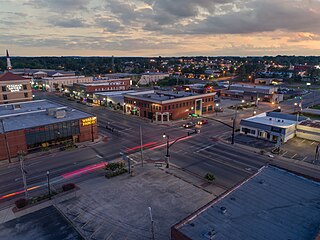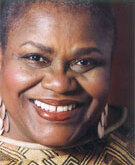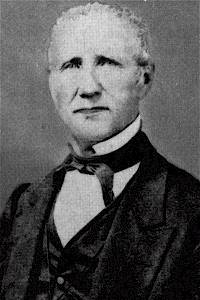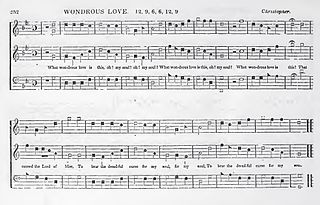Related Research Articles

Cullman is the largest city and county seat of Cullman County, Alabama, United States. It is located along Interstate 65, about 50 miles (80 km) north of Birmingham and about 55 miles (89 km) south of Huntsville. As of the 2010 census it had a population of 14,775, with an estimated population of 16,034 in 2019.

Gertrude "Ma" Rainey was one of the earliest African-American professional blues singers and one of the first generation of blues singers to record. The "Mother of the Blues", she bridged earlier vaudeville and the authentic expression of southern blues, influencing a generation of blues singers.

Bernice Johnson Reagon is a song leader, composer, scholar, and social activist, who in the early 1960s was a founding member of the Student Non-violent Coordinating Committee's (SNCC) Freedom Singers in the Albany Movement in Georgia. In 1973, she founded the all-black female a cappella ensemble Sweet Honey in the Rock, based in Washington, D.C. Reagon, along with other members of the SNCC Freedom Singers, realized the power of collective singing to unify the disparate groups who began to work together in the 1964 Freedom Summer protests in the South.
“After a song,” Reagon recalled, “the differences between us were not so great. Somehow, making a song required an expression of that which was common to us all.... This music was like an instrument, like holding a tool in your hand.”

Shape notes are a musical notation designed to facilitate congregational and social singing. The notation, introduced in late 18th century England, became a popular teaching device in American singing schools. Shapes were added to the noteheads in written music to help singers find pitches within major and minor scales without the use of more complex information found in key signatures on the staff.

William Billings is regarded as the first American choral composer, and leading member of the First New England School.

Sacred Harp singing is a tradition of sacred choral music that originated in New England and was later perpetuated and carried on in the American South of the United States. The name is derived from The Sacred Harp, a ubiquitous and historically important tunebook printed in shape notes. The work was first published in 1844 and has reappeared in multiple editions ever since. Sacred Harp music represents one branch of an older tradition of American music that developed over the period 1770 to 1820 from roots in New England, with a significant, related development under the influence of "revival" services around the 1840s. This music was included in, and became profoundly associated with, books using the shape note style of notation popular in America in the 18th and early 19th centuries.
A singing school is a school in which students are taught to sightread vocal music. Singing schools are a long-standing cultural institution in the Southern United States. While some singing schools are offered for credit, most are informal programs.

William Walker was an American Baptist song leader, shape note "singing master", and compiler of four shape note tunebooks, most notable of which are the influential The Southern Harmony and the Christian Harmony, which has been in continuous use.

Benjamin Franklin White was a shape note "singing master", and compiler of the shape note tunebook known as The Sacred Harp. He was born near Cross Keys in Union County, South Carolina, the twelfth child of Robert and Mildred White.
Thomas Jackson Denson was a notable Alabama musician and singing school teacher within the Sacred Harp tradition. He was the youngest of the four sons of the Levi Phillip Denson, a farmer, a gold miner in Arbacoochee, Cleburne County and a Methodist minister, and Julia Ann Jones Denson. Thomas J. Denson was born in 1863 in Arbacoochee and named after Stonewall Jackson. He was married to Amanda Burdette, a music and literary teacher, a singer, and song composer, until her death in 1910; she was the younger sister of Sidney Burdette, his brother's wife. They had five children: two sons, Paine W. Denson and William Howard Denson; and three daughters, Anna Eugenia Denson, Maggie Francis Denson, and Jarusha Henrietta Denson. In 1914, he married Lola Mahalia Akers, with whom he had three daughters: Violet Denson Hinton, Vera Denson Nunn, and Tommye Mahalia Denson Mauldin.

Seaborn McDaniel Denson was a notable Alabama musician and singing school teacher within the Sacred Harp tradition. He was a son of The Rev. Levi Phillips Denson, a Methodist minister, and Julia Ann Jones Denson. Seaborn Denson was born April 9, 1854 in Arbacoochee, Alabama. He married Sidney Burdette.
Wilson Marion Cooper of Dothan, Alabama, was a notable musician and music teacher within the Sacred Harp tradition. Marion Cooper was born in Henry County, Alabama, the son of W. S. and Elizabeth Ann (Oates) Cooper. He was a cousin of Alabama governor William C. Oates.
Joseph Stephen James, of Douglasville, Georgia, was a lawyer, community leader, shape note singer, composer, and a reviser of the tunebook known as The Sacred Harp.
The Chattahoochee Musical Convention is a Sacred Harp singing convention. It is an annual gathering whose purposes are worshiping our Lord through the singing of Sacred Harp music and fostering of bonds of fellowship among singers. It bears the distinction of being the oldest surviving Sacred Harp musical convention, having been founded in 1852.

Jo Ann Gibson Robinson was an activist during the Civil Rights Movement and educator in Montgomery, Alabama.
The Sacred Harp is a shape note tunebook, originally compiled in 1844 by Benjamin Franklin White and Elisha J. King in Georgia and used to this day in revised form by Sacred Harp singers throughout America and overseas. This article is a historical overview and listing of the composers and poets who wrote the songs and texts of The Sacred Harp.
Hugh McGraw was a leading figure in contemporary Sacred Harp singing. He was the General Chairman of the committee that created the 1991 Denson revision of The Sacred Harp and played an important role in promoting the spread of Sacred Harp singing. Sacred Harp scholar Buell Cobb has called him "perhaps the chief promoter and good will agent of Sacred Harp music."

Ruby Hurley was a leader in the Civil Rights Movement and administrator for the NAACP. She was known as the "queen of civil rights".

"What Wondrous Love Is This" is a Christian folk hymn, sometimes described as a "white spiritual", from the American South. Its text was first published in 1811, during the Second Great Awakening, and its melody derived from a popular English ballad. Today it is a widely known hymn included in hymnals of many Christian denominations.

Alfred Marcus Cagle was an American hymnwriter known for his activities with the Sacred Harp movement.
References
- 1 2 David Warren Steel; Richard H. Hulan (2010). The Makers of the Sacred Harp. University of Illinois Press. pp. 50–. ISBN 978-0-252-03567-8.
- ↑ Buell E. Cobb, Jr. (1 December 2004). The Sacred Harp: A Tradition and Its Music. University of Georgia Press. pp. 145–. ISBN 978-0-8203-2371-8.
- ↑ Directory and Minutes of Annual Sacred Harp Singings. s.n. 1981.
| This article on a United States composer born in the 19th century is a stub. You can help Wikipedia by expanding it. |